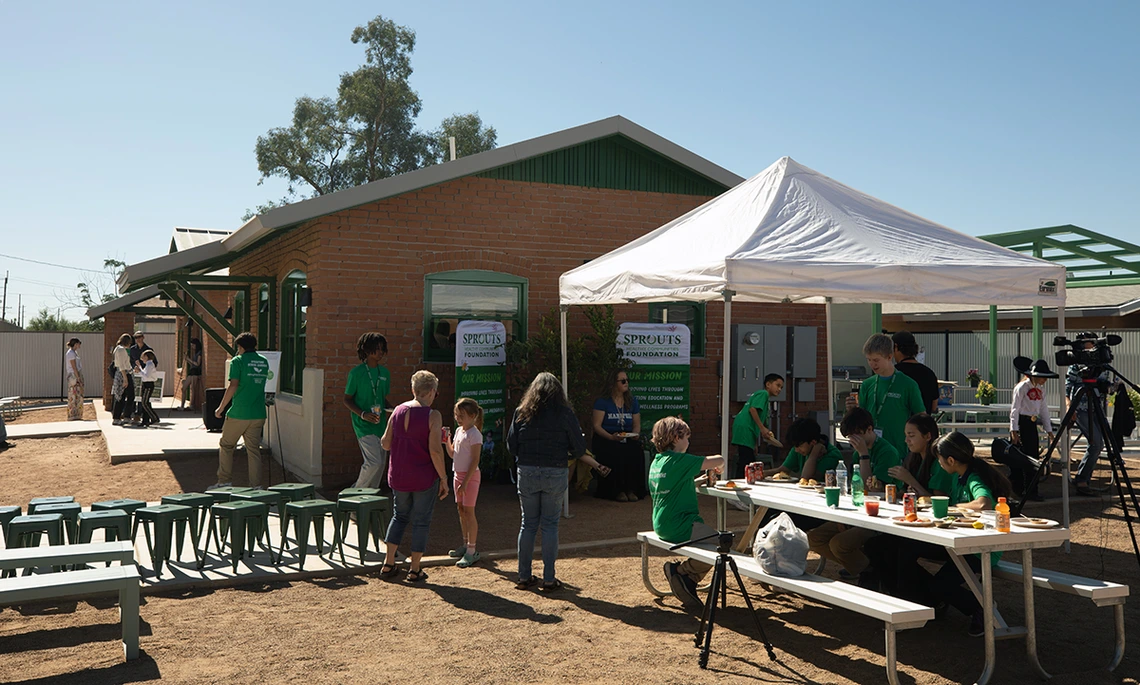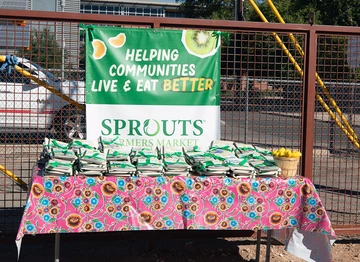Taking root: Sprouts House brings new life to abandoned homes

The Sprouts House, located at 415 N. Mountain Ave., is a place where Tucson Unified School District students will grow vegetables, cook meals together and learn firsthand how food moves from garden to kitchen to table.
Mackenzie Virdee
Two long-forgotten houses on a quiet Tucson street south of campus have been transformed into the Sprouts House, a vibrant learning space for Tucson Unified School District students and home of the university's School Garden Workshop. Within the new space, students will soon grow vegetables, cook meals together and learn firsthand how food moves from garden to kitchen to table.

Before (above) and after images of the bungalows at 415 N. Mountain Ave. that were renovated into the Sprouts House in less than a year.
Planning, Design and Construction; Mackenzie Virdee
At a Nov. 7 event, community members and leaders from the College of Social and Behavioral Sciences, TUSD, the Sprouts Healthy Communities Foundation and U.S. Representative Adelita Grijalva, gathered to celebrate the Sprouts House. The celebration marked a dramatic turnaround for the bungalows at 415 N. Mountain Ave. (next door to Mansfeld Middle School) which, just a year ago, were abandoned, peeling and nearly beyond saving. Today, they stand fully restored and ready to welcome students from across the community.
That transformation began when Moses Thompson, executive director of the School Garden Workshop, secured a $1 million lead gift from the Sprouts Healthy Communities Foundation – part of a $2.5 million fundraising effort – and brought the vision to the University Facilities Services team.
Leading the renovation was Mike Seal of UFS, a chief building inspector stepping into his first project management role.
"They came to us with an idea, and we helped turn it into a full project, getting the contractor, architect and everyone else on board," Seal said, describing the collaborative effort that turned the two deteriorating buildings into fully restored, functional learning spaces.

Michael Seal
Bringing the right people together
Renovation went quickly, beginning in the spring of 2025 and taking less than a year to complete. A project of this complexity required deep collaboration across campus, and Seal spent months working with units essential to the renovation's success. Environmental Health and Safety oversaw the environmental testing that allowed the crew to begin construction once the buildings were cleared of hazards. Real Estate and the State Historic Preservation Office reviewed every exterior element, from window styles and paint colors to fencing and hardware, to ensure the houses maintained their historic character as they were rehabilitated.
"Anything that happens with a historical house has to be run by that group," Seal said. "These were old houses. One was from 1921 and the other from 1933, and they had to stay true to that historical look. Every window, door and fence had to be approved."
Seal also coordinated with University Information Technology Services on low-voltage systems and the Lock Shop on building access. The University of Arizona Police Department, which is involved in every UFS project, played a key role, as did the Campus Sustainability Fund in the university's Office of Sustainability, which has provided funding to create a rainwater harvesting system.
On the ground, the project demanded even more teamwork. The narrow site required coordination with Parking and Transportation to manage up to 20 construction trucks each day, while keeping school drop-off routes clear and safe.
"It's a tiny site," he said. "Trying to keep it clear for parents to drop off kids while we had 20 construction trucks there took a lot of coordination."
In total, between 20 and 30 people contributed to the renovation, including subcontractors, the general contractor Chasse Building Team, the architect of record, Poster Mirto McDonald, and members of Thompson's group.
"They worked their butts off – so did all the subcontractors," Seal said. "Everyone came together to make it happen."
While Seal led the construction, the driving force behind the vision and educational mission for Sprouts House came from Thompson and the School Garden Workshop.

Among the giveaways at the Nov. 7 dedication were school garden almanacs.
Mackenzie Virdee
Growing an impact
Housed in the School of Geography, Development and Environment, within the College of Social and Behavioral Sciences, the School Garden Workshop has spent 15 years connecting K–12 students to food, community and the environment through hands-on learning. The program partners with under-resourced schools across Tucson, placing U of A student interns with TUSD teachers to help maintain gardens and integrate garden-based lessons into their curriculum.
The Sprouts House will serve as the new headquarters for the program. It includes a kitchen, a classroom, a greenhouse and an outdoor teaching area and garden, offering TUSD students hands-on experience with growing food.
"Sprouts House will be the linchpin in the School Garden Workshop's K-12 school garden pipeline and the coalescence of 15 years of experience, deep community need and the perfect time and place," said Thompson.
For Seal, every long day and logistical challenge was justified by what the space would become once it was in the hands of students.
"Moses and the kids are going to plant, grow, cook and then sit on the patio and eat the veggies they grew. That's what it's all about," he said, noting that even decisions like making the site fully ADA accessible "from the street all the way to the back patio" were about ensuring every student could be part of the experience.
After watching the two abandoned houses evolve into a place built for learning, connection and belonging, Seal reflected in the end: "It feels unbelievable, honestly. Knowing it's for the kids and the community makes it all worth it."

